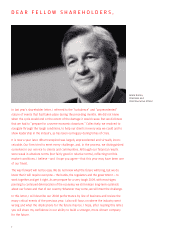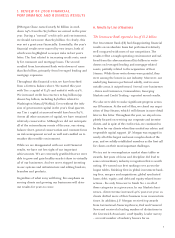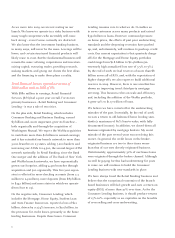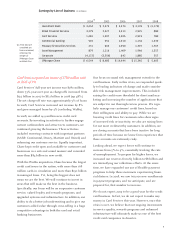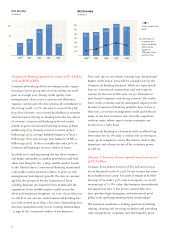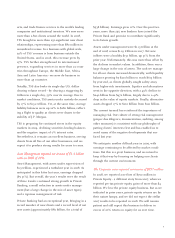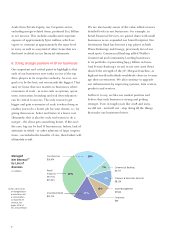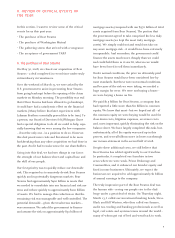JP Morgan Chase 2008 Annual Report Download - page 14
Download and view the complete annual report
Please find page 14 of the 2008 JP Morgan Chase annual report below. You can navigate through the pages in the report by either clicking on the pages listed below, or by using the keyword search tool below to find specific information within the annual report.
12
the worst of the crisis. We will do whatever it takes
to ensure that our liquidity remains a strong part of
our fortress balance sheet so that we can maintain
flexibility during challenging times to be in a posi-
tion to support our clients.
• We avoided short-term funding of illiquid assets,
and we essentially do not rely on wholesale funding.
(Of our $1 trillion of deposits, approximately $300
billion is referred to as “wholesale,” but it essentially
is comprised of deposits that corporate clients leave
with us in the normal course of business – i.e., they
are “sticky” and not like brokered certificates of
deposit or “hot money” that move on a whim for one
basis point.) Simply put, we still follow the financial
commandment: Do not borrow short to invest long.
D. The acceptance of government TARP
On October 13, 2008, I went to Washington, D.C., with
eight chief executives of other financial firms. There,
we were asked by the Secretary of the Treasury, the
Chairman of the Federal Reserve, the Office of the
Comptroller of the Currency (OCC), the FDIC and the
New York Federal Reserve Bank to agree to accept a
package of capital from the government. As part of its
Troubled Asset Relief Program (TARP), the U.S. gov-
ernment was proposing some powerful measures to
help fix the collapse in the credit and lending markets.
They prevailed upon the nine of us to set an example
for others by accepting this capital infusion as a sign
of our unanimous support of these measures. The logic
was that a massive infusion of capital into the U.S.
banking system would pave the way for the industry
as a whole to extend more credit than they otherwise
would have provided. The government’s view was also
that if any of the banks declined the TARP funds, then
many of the additional banks might not want to be
tainted by their acceptance of the TARP money
because it might be viewed as a sign of weakness.
We felt then that accepting the TARP funds was the right
thing to do for the U.S. financial system – even though it
may not have been as beneficial for JPMorgan Chase as
it was for some of the others
In short, we did not ask for the TARP capital infusion,
and we did not feel we needed it (our Tier 1 capital at
year-end would have been 8.9% without it). In fact,
the TARP program had asymmetric benefits to those
accepting it; i.e., it was least beneficial to strong com-
panies like ours and vice versa. That said, we believe
that accepting the TARP funds was the right thing to
do for the U.S. financial system – and that JPMorgan
Chase should not be parochial or selfish and stand in
the way of actions that the government wanted to take
to help the whole financial system.
7.5
8.0
8.5
9.0
7.0
6.5
9.5
10.0
2004 2005 20072006
8.7%
8.3%
8.5%
8.2%
8.7%
8.4%
7.2%
8.4%
2008
9.6%
10.9%
(a)
11.0%
10.5
Peer Comparison of Tier 1 Capital Ratios
Tier 1 Capital Ratio — JPMorgan Chase
Average Tier 1 Capital Ratio — Peers
(Bank of America, Citi, Wells Fargo
and Wachovia; 2008 peer capital ratio
excludes Wachovia)
(a) 2004 data are unaudited pro forma
combined, reflecting the merger of
JPMorgan Chase and Bank One


